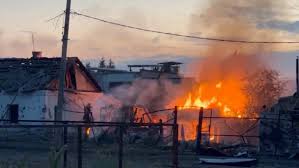Ukrainian Assault on Russian Territory Reaches Fifth Day
3 min read

Ukrainian forces have continued their cross-border assault into Russia’s western Kursk region for a fifth consecutive day. This unexpected offensive has escalated tensions and drawn significant international attention.
According to the Russian Defense Ministry, it is actively working to repel the Ukrainian troops, claiming that over 280 Ukrainian personnel have been killed in the last 24 hours, though this figure remains unverified by independent sources. Reports indicate that Ukrainian forces have advanced more than 10 kilometers (approximately six miles) into Russian territory, marking their deepest penetration since Russia’s full-scale invasion of Ukraine in February 2022.
While Ukraine has not officially acknowledged the incursion, President Volodymyr Zelensky has stated that Russia needs to “feel” the repercussions of its ongoing invasion of Ukraine. The fighting has brought conflict perilously close to a nuclear power plant in the Kursk region, prompting the International Atomic Energy Agency (IAEA) to issue a plea for both sides to exercise utmost restraint. IAEA chief Rafael Grossi warned of the potential for a nuclear accident if the conflict continues near the facility.
The situation has led to the evacuation of some Kursk residents, with a group arriving at Moscow’s central train station on Friday. One resident described the situation as “terrible,” citing the bombings in the area. In response to the heightened threat, the Russian Defense Ministry has mobilized additional troops and heavy armor to the Kursk region, declaring a counter-terrorist operation. This declaration grants local authorities increased powers, including restrictions on movement and temporary evacuations.
In a separate development, Ukraine’s military reported a successful strike on a Russian airfield in Lipetsk, located over 350 kilometers (217 miles) from the Ukrainian border. This attack destroyed a warehouse containing hundreds of glide bombs, a type of weaponry that Russia has used extensively in its attacks on Ukrainian towns and military positions. The airfield, known to house Russian Su-34, Su-35, and MiG-31 aircraft, was targeted as part of Ukraine’s broader strategy to disrupt Russia’s military capabilities.
Following Ukraine’s strikes, Russia retaliated by targeting a shopping center in Kostyantynivka, a town near the frontline in the eastern Donetsk region. The attack resulted in at least 14 deaths and 43 injuries, with damage reported to residential buildings, shops, and numerous vehicles.
Russian authorities reported a state of emergency in Lipetsk following the Ukrainian strikes and confirmed “detonations” at an energy infrastructure facility. Evacuations were carried out in four nearby villages as a precaution.
Despite the Russian Defense Ministry’s claims of successfully suppressing Ukrainian raids, a BBC Verify video revealed substantial damage to a 15-vehicle Russian convoy, with vehicles burned and abandoned on a road in the town of Oktyabrskoe, about 38 kilometers (24 miles) from the border. The footage also showed injured and possibly deceased Russian soldiers among the wreckage.
Russia initially claimed that up to 1,000 Ukrainian troops, supported by tanks and armored vehicles, had entered Kursk at the onset of the offensive. Despite deploying reserve troops and issuing evacuation orders, Russia has struggled to contain the Ukrainian advance. This sustained offensive is unprecedented in scale and has surprised both Russian military leaders and the Kremlin, which has faced criticism for its inability to prevent the incursion.
While Western allies of Ukraine have largely supported the operation as a legitimate act of self-defense, the Ukrainian forces remain outnumbered by the Russian military. The outcome of this high-risk maneuver could pivot on whether it is deemed a strategic masterstroke or a dangerous miscalculation.
The Ukrainian offensive has also impacted global financial markets, with the Russian rouble falling by 2.5% against the dollar on Friday. Traders cited the ongoing conflict in Kursk as a contributing factor to the currency’s decline, underscoring the broader economic ramifications of the intensified conflict.